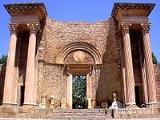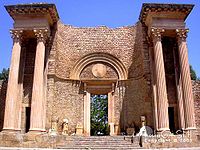
Saint Possidius
Encyclopedia
Possidius was a friend of Saint Augustine of Hippo who wrote a reliable biography and an indiculus or list of his works. He was bishop of Calama
in the Roman province
of Numidia
.
 The dates of his birth and death are unknown; he was alive and in exile in 437 according to Prosper
The dates of his birth and death are unknown; he was alive and in exile in 437 according to Prosper
, who, in his Chronicle, records that Possidius and two other bishops were persecuted and expelled from their sees by the Vandal
king, Gaiseric, who was an Arian
. Possidius (Vita S. Augustini, xxxi), after describing the death of Augustine, speaks of his unbroken friendship with him for forty years. He also, speaking of himself in the third person, lets it be known that he was one of the clergy of St. Augustine's monastery (ibid., xii).
The date of his promotion to the episcopate was, according to Tillemont, about 397. He followed St. Augustine's example and established a monastery at Calama. At a council held at Carthage
, Possidius challenged Crispinus, the Donatist
Bishop of Calama, to a public discussion which the latter declined. Shortly afterwards one of Crispinus's clergy, bearing the same name as his bishop, attempted to assassinate Possidius. Legal proceedings were instituted against Crispinus, the bishop, who refused to punish his presbyter
. He was condemned for heresy
and was heavily fined, but at the intercession of Possidius the fine was not exacted ("Vita", xii; St. Augustine, "Ep.", cv, 4; "Contra Crescon.", III, xlvi).
In 407, Possidius served, with St. Augustine and five other bishops, on a committee appointed to adjudicate upon some ecclesiastical matter, the particulars of which are not known. In 408 he nearly lost his life in a riot
stirred up by the pagans at Callama (St. Augustine, "Epp.", xc, xci, xciii). In 409 he was one of four bishops deputed to go to Italy to obtain the protection of the emperor against the Donatists. He was one of the seven bishops chosen to represent the Catholic party at the collatio of 411.
In 416 he assisted at the Council of Milevum, where fifty-nine Numidian bishops addressed a synodal letter to Innocent I, asking him to take action against Pelagianism
. He joined with St. Augustine and three other bishops in a further letter to Innocent on the same subject, and was at the conference between St. Augustine and the Donatist Emeritus. When the Germanic Vandals
invaded Africa, he fled to Hippo and was present at the death of St. Augustine (430).
Guelma
Guelma is the capital of Guelma Province and Guelma District, located in northeastern Algeria, about 65 kilometers from the Mediterranean coast...
in the Roman province
Roman province
In Ancient Rome, a province was the basic, and, until the Tetrarchy , largest territorial and administrative unit of the empire's territorial possessions outside of Italy...
of Numidia
Numidia
Numidia was an ancient Berber kingdom in part of present-day Eastern Algeria and Western Tunisia in North Africa. It is known today as the Chawi-land, the land of the Chawi people , the direct descendants of the historical Numidians or the Massyles The kingdom began as a sovereign state and later...
.
Biography

Prosper
Prosper may refer to:In people:* Prosper de Mestre Sydney businessman fom 1818 to 1844* Prosper of Aquitaine, also known as Prosper Tiro, Christian writer and disciple of St Augustine* Prosper of Catenanuova, martyr, patron saint of Catenanuova...
, who, in his Chronicle, records that Possidius and two other bishops were persecuted and expelled from their sees by the Vandal
Vandals
The Vandals were an East Germanic tribe that entered the late Roman Empire during the 5th century. The Vandals under king Genseric entered Africa in 429 and by 439 established a kingdom which included the Roman Africa province, besides the islands of Sicily, Corsica, Sardinia and the Balearics....
king, Gaiseric, who was an Arian
Arianism
Arianism is the theological teaching attributed to Arius , a Christian presbyter from Alexandria, Egypt, concerning the relationship of the entities of the Trinity and the precise nature of the Son of God as being a subordinate entity to God the Father...
. Possidius (Vita S. Augustini, xxxi), after describing the death of Augustine, speaks of his unbroken friendship with him for forty years. He also, speaking of himself in the third person, lets it be known that he was one of the clergy of St. Augustine's monastery (ibid., xii).
The date of his promotion to the episcopate was, according to Tillemont, about 397. He followed St. Augustine's example and established a monastery at Calama. At a council held at Carthage
Carthage
Carthage , implying it was a 'new Tyre') is a major urban centre that has existed for nearly 3,000 years on the Gulf of Tunis, developing from a Phoenician colony of the 1st millennium BC...
, Possidius challenged Crispinus, the Donatist
Donatist
Donatism was a Christian sect within the Roman province of Africa that flourished in the fourth and fifth centuries. It had its roots in the social pressures among the long-established Christian community of Roman North Africa , during the persecutions of Christians under Diocletian...
Bishop of Calama, to a public discussion which the latter declined. Shortly afterwards one of Crispinus's clergy, bearing the same name as his bishop, attempted to assassinate Possidius. Legal proceedings were instituted against Crispinus, the bishop, who refused to punish his presbyter
Presbyter
Presbyter in the New Testament refers to a leader in local Christian congregations, then a synonym of episkopos...
. He was condemned for heresy
Heresy
Heresy is a controversial or novel change to a system of beliefs, especially a religion, that conflicts with established dogma. It is distinct from apostasy, which is the formal denunciation of one's religion, principles or cause, and blasphemy, which is irreverence toward religion...
and was heavily fined, but at the intercession of Possidius the fine was not exacted ("Vita", xii; St. Augustine, "Ep.", cv, 4; "Contra Crescon.", III, xlvi).
In 407, Possidius served, with St. Augustine and five other bishops, on a committee appointed to adjudicate upon some ecclesiastical matter, the particulars of which are not known. In 408 he nearly lost his life in a riot
Riot
A riot is a form of civil disorder characterized often by what is thought of as disorganized groups lashing out in a sudden and intense rash of violence against authority, property or people. While individuals may attempt to lead or control a riot, riots are thought to be typically chaotic and...
stirred up by the pagans at Callama (St. Augustine, "Epp.", xc, xci, xciii). In 409 he was one of four bishops deputed to go to Italy to obtain the protection of the emperor against the Donatists. He was one of the seven bishops chosen to represent the Catholic party at the collatio of 411.
In 416 he assisted at the Council of Milevum, where fifty-nine Numidian bishops addressed a synodal letter to Innocent I, asking him to take action against Pelagianism
Pelagianism
Pelagianism is a theological theory named after Pelagius , although he denied, at least at some point in his life, many of the doctrines associated with his name. It is the belief that original sin did not taint human nature and that mortal will is still capable of choosing good or evil without...
. He joined with St. Augustine and three other bishops in a further letter to Innocent on the same subject, and was at the conference between St. Augustine and the Donatist Emeritus. When the Germanic Vandals
Vandals
The Vandals were an East Germanic tribe that entered the late Roman Empire during the 5th century. The Vandals under king Genseric entered Africa in 429 and by 439 established a kingdom which included the Roman Africa province, besides the islands of Sicily, Corsica, Sardinia and the Balearics....
invaded Africa, he fled to Hippo and was present at the death of St. Augustine (430).
Works
- His Vita S. Augustini, composed before the capture of CarthageCarthageCarthage , implying it was a 'new Tyre') is a major urban centre that has existed for nearly 3,000 years on the Gulf of Tunis, developing from a Phoenician colony of the 1st millennium BC...
(439), is included in all editions of the works of St. Augustine, and also printed in HurterHurterThe von Hurter family belonged to the Swiss nobility; in the eighteenth and nineteenth centuries three of them were known for their conversions to Roman Catholicism, their ecclesiastical careers in Austria and their theological writings.- Life :...
's "Opusc. SS. Patr.". - His indiculus ('small index') will be found in the last volume of Migne's edition of the works of St. Augustine and in the tenth volume of the Benedictine edition.
Sources
- Ceillier, Hist. des auteurs ecclés., XII
- Tillemont, Mémoires, XIII. ISBN 1889758906 ISBN 9781889758909

